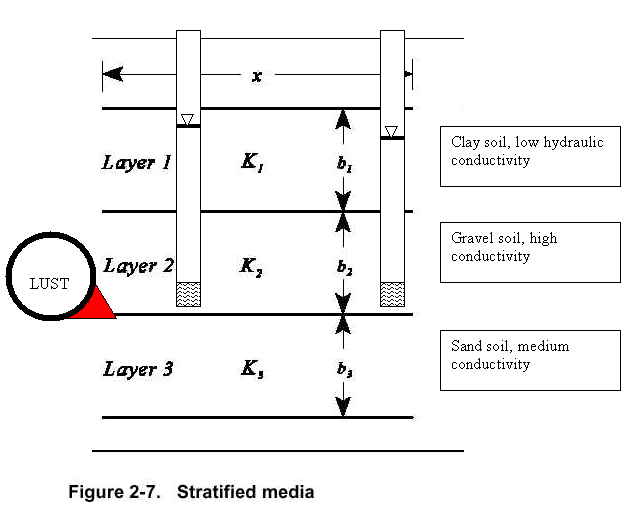
Learning Goals
The module will familiarize you with some basic groundwater concepts and terminology. After you complete this module, you should feel comfortable with the groundwater terms used in the RISC model. Some vocabulary words are presented at the end of this module, and you should be familiar with those.
Learning Method
There is a chapter in the Corps of Engineers Groundwater Hydrology Manual which is available on the web. It has clear explanations of the concepts we are interested in. The main focus of the manual is on water supply, while we are interested in contaminant transport, so about half the chapter we can skip. So below I have indicated by sections of the chapter, what you should read and what you should skip, and also some notes of mine that add some material and explainations.
Pull down Chapter 2
Read 2-1 and 2-2.
Read 2-3. Note: In the unsaturated zone, there is a three phase mixture of air, water, and soil, (often a fourth phase, NAPL, or non-aqueous phase liquids, i.e., what leaked out of the underground fuel tank.) While the saturated zone has only two: the water and the soil phase.
Read 2-4 and 2-5. Note Figure 2-3, note how a well works. Water only gets into the well through the screened portion of the casing. Above the screen in the annulus is packed a clay material that does not permit water to flow up from around the casing. The upside down triangle indicates the water level in the well.
Read 2-5 and skip 2-6
Read 2-7 and 2-8. In 2-8.f note that "bed rock" is assumed impermeable, while "rock" is generally fractured and might be quite permeable.
Read 2-9 and 2-10a. Note in 2-10a, Table 2-1, note how porosity varies with soil type. Skip 2-10b and c.
2-11a and b. Note that if you are given the difference in head and the hydraulic conductivity and cross sectional area of the aquifer, you can calculate the velocity of the water (and your contaminant). Skip c and d.
Skip 2-12
Skim 2-13a and b and 2-14, but here is a summary that is important. Soils are not homogeneous, they are very heterogeneous. If you dig a hole and examine the layers, the hydraulic conductivity is rarely the same in different layers of soil. Now digging a trench for some distance in one direction, we see that the layers are neither uniform nor continuous. The word "isotropic" means that the property of interest is the same in all directions. The word "anisotropic" means the property is not the same in all directions. Look at figure 2-7 and here: Suppose that Layer 1 is a clay soil that has a very low hydraulic conductivity, Layer 2 is a gravel with a high hydraulic conductivity, and Layer 3 is a sand with an intermediate conductivity.
Look at the water level in the wells. "LUST" means leaking underground storage tank. Which way is the groundwater flowing

So, based on the description of the soils, K2 > K3 >>K1. Let's assume that the layers are equal thickness.
The tank full of red product ruptures, where is the product some time later?
ENVE 651 Homepage Module 9 Index